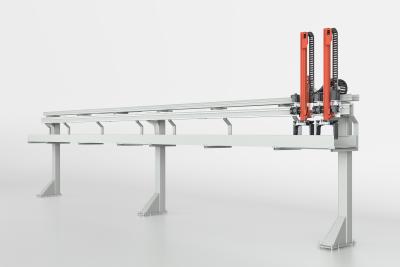
The new LP 100 gantry robot system introduced recently by Liebherr-Verzahntechnik GmbH is ideal for handling small and light components, allowing users the option of configuring the gantry to deliver high-speed or high-load performance. This choice allows the LP 100 to be employed flexibly, which fits well with inline production concepts where workpieces travel longer distances across several production machines.
The new size gantry robot offers engine and gearbox manufacturers many more options to select optimal solutions that work for them. It is suitable for use in the weight category that includes cylinder heads and gearbox housings, as well as alternative drivetrain units, like electric or hybrid engines, fuel cells or components of a similar size.
The design of the gantry robot has been adapted to meet the wide range of modern production process requirements. “The new design enables our customers, for example, to select a wider clearance between uprights,” Thomas Mattern, Head of Automation Systems Development at Liebherr-Verzahntechnik GmbH, explains. “System planners thus have extra production-line design and installation options.”
The LP 100 gantry robot operates at the lower end of the larger Liebherr LP 200’s weight range, where high speed is not required, and represents an inexpensive alternative. It is also an option in the upper weight range of the current LP 20, which is not designed for heavy loads at high speeds.
Additional modules like extra axles, grippers, quick-change systems or similar require an increased load capacity. If several of these peripheral equipment modules are required in a particular application, the load range of the smaller LP 20 gantry robot is insufficient.
Today, the “inline concept,” featuring long travel ways, dominates production lines. Loading gantries handle transportation of workpieces, as well as loading and unloading of machines. Conveyor belt systems for the transportation of workpieces are now only required to a lesser extent. In addition, the number of machines covered by a single loading gantry is increasing, in order to increase production capacity and minimize use of automation systems.
“Changes in production line design have an impact on automation – workpieces have to travel longer distances at higher speeds,” Mattern explains. “The fact that machinery and machining centers are getting faster and faster is also putting pressure on cycle times. We, of course, factor in these trends when designing and developing our gantries and provide the appropriate solutions, e.g. high-speed versions.”
With the two versions (high-load and high-speed versions) Liebherr says it offers optimal-sized, cost-effective automation solutions for all industries with no limitations on functionality and performance.
“Downsizing” is a growing trend in the automotive sector with engines becoming more efficient and therefore smaller and lighter. Production facilities are also adapting to these changes. Market analyses conducted by Liebherr have motivated the company to adapt its range of gantry robots to match this trend.
Related Glossary Terms
- centers
centers
Cone-shaped pins that support a workpiece by one or two ends during machining. The centers fit into holes drilled in the workpiece ends. Centers that turn with the workpiece are called “live” centers; those that do not are called “dead” centers.
- clearance
clearance
Space provided behind a tool’s land or relief to prevent rubbing and subsequent premature deterioration of the tool. See land; relief.
- gantry robot
gantry robot
Robot positioned by means of an overhead supporting structure such as a crane or bridge-type support.






